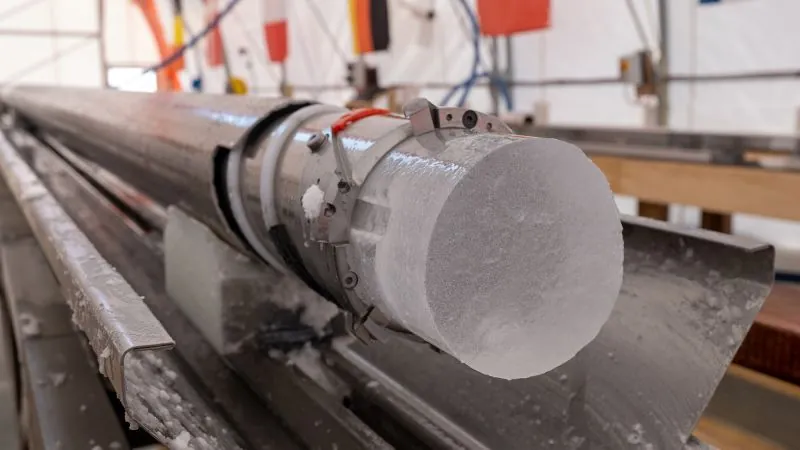
Antarctic Ice Core Unlocks Secrets of Ancient Climate, Scientists Revealed!
2025-01-11
Author: Arjun
A breakthrough discovery in Antarctica
A groundbreaking discovery has emerged from the icy expanse of Antarctica, where an international team of scientists has successfully extracted a colossal 9,186-foot-long (2,800-meter) ice core, dating back an astonishing 1.2 million years. This ambitious drilling mission reached bedrock beneath the Antarctic Ice Sheet, presenting a new front in our understanding of ancient climates.
Dubbed a "time machine" by Carlo Barbante, the coordinator of the Beyond EPICA project—an acronym for the European Project for Ice Coring in Antarctica—this remarkable core serves as an extraordinary archive of Earth’s climatic history. The core has been sliced into manageable 3.2-foot (1-meter) segments, securely stored in insulated boxes for intensive study.
Research Site and Conditions
Located at Little Dome C, an area renowned for its extreme conditions, this research site is situated about 21 miles (34 kilometers) from the Italian-French Concordia research station. Here, researchers face fierce winds and bone-chilling temperatures that often plummet below minus 40 degrees Fahrenheit (minus 40 degrees Celsius).
The insights gleaned from this ancient ice could illuminate some of Earth's most significant climate questions, particularly how it has evolved over time. The core contains air bubbles that provide crystal-clear snapshots of the ancient atmosphere, revealing past concentrations of greenhouse gases like carbon dioxide and methane. Barbante indicates that by examining these trapped gases, scientists hope to reconstruct the Earth’s climatic responses to various factors, including solar radiation and volcanic activity.
Understanding Ice Ages
But what truly ignites fascination is the core's potential to clarify the drastic shift in the timing of the Earth’s ice ages approximately 1 million years ago. This marked a troublesome period for ancient human ancestors and could have played a pivotal role in shaping the course of human evolution, according to recent archaeological studies.
An Engineering Marvel
The exploration that led to this milestone was conducted during the fourth campaign of the Beyond EPICA—Oldest Ice project, which received funding from the European Commission. Over several Antarctic summers, spanning more than 200 days across four seasons, researchers conducted rigorous drilling and processing to capture this ice core.
The new core extends the climate record beyond the previous EPICA project, which unearthed connections between climate and atmospheric gases over the past 800,000 years. The newly retrieved ice holds the key to understanding glacial cycles—historically every 100,000 years—and their relationship to warmer interglacial periods. These findings are poised to reconcile previous discrepancies revealed by marine sediment studies suggesting a 41,000-year cycle before 1 million years ago.
Site Selection and Challenges
This ambitious project has drawn upon advanced radar surveys to identify sites with optimal ice thickness that would not have succumbed to melting. Frank Wilhelms, one of the principal investigators, described the rigorous site examination as an essential step toward ensuring successful drilling.
Peering into Ancient Responsibilities
Upon retrieving the core, researchers were eager to delve into the oldest, heavily deformed layers that could reveal unique characteristics and histories of the ice. They aim to determine whether even more ancient ice is present and verify the geological history that has shaped this Antarctic region over millions of years.
As highlighted by glaciologist Dr. Robert Mulvaney, each meter of the core encapsulates approximately 13,000 years of climate data, making this study particularly vital for understanding how our planet's climate mechanisms have functioned over extended timeframes.
The Future of Climate Understanding
In the wake of the Mid-Pleistocene Transition—an era marked by significant climatic changes between 1.2 million and 900,000 years ago—scientists remain compelled to decipher the complex dynamics of greenhouse gases and ice sheet behavior that propelled this transition. It was during this tumultuous time that the Earth’s ice ages became more prolonged and severe, leading to significant drops in temperature and a dramatic decrease in global population—a dire situation for early human ancestors.
Ice cores, often regarded as nature’s record keepers, contain invaluable layers that encapsulate historical snowfall, trapping air bubbles and particles within. The analysis of these bubbles can provide researchers insights into past temperature fluctuations and shifts in atmospheric conditions.
Jim White, a distinguished climate scientist, likens Antarctic ice cores to "Rosetta Stones" of climate history. They encapsulate essential data about past climates and their interactions with evolving greenhouse gas concentrations, aiding predictions of future climate behavior.
As this pioneering ice core undergoes in-depth analysis back in Europe, secured aboard the icebreaker Laura Bassi, the next phase of research promises to uncover further secrets from our planet’s climatic past. The Beyond EPICA project remains committed to expanding its exploration, aiming to identify even older ice with potential for a more comprehensive understanding of Earth’s climate history.
Conclusion
Stay tuned to see how these frozen archives could redefine our grasp of climate change and its far-reaching effects on life as we know it!

 Brasil (PT)
Brasil (PT)
 Canada (EN)
Canada (EN)
 Chile (ES)
Chile (ES)
 Česko (CS)
Česko (CS)
 대한민국 (KO)
대한민국 (KO)
 España (ES)
España (ES)
 France (FR)
France (FR)
 Hong Kong (EN)
Hong Kong (EN)
 Italia (IT)
Italia (IT)
 日本 (JA)
日本 (JA)
 Magyarország (HU)
Magyarország (HU)
 Norge (NO)
Norge (NO)
 Polska (PL)
Polska (PL)
 Schweiz (DE)
Schweiz (DE)
 Singapore (EN)
Singapore (EN)
 Sverige (SV)
Sverige (SV)
 Suomi (FI)
Suomi (FI)
 Türkiye (TR)
Türkiye (TR)
 الإمارات العربية المتحدة (AR)
الإمارات العربية المتحدة (AR)